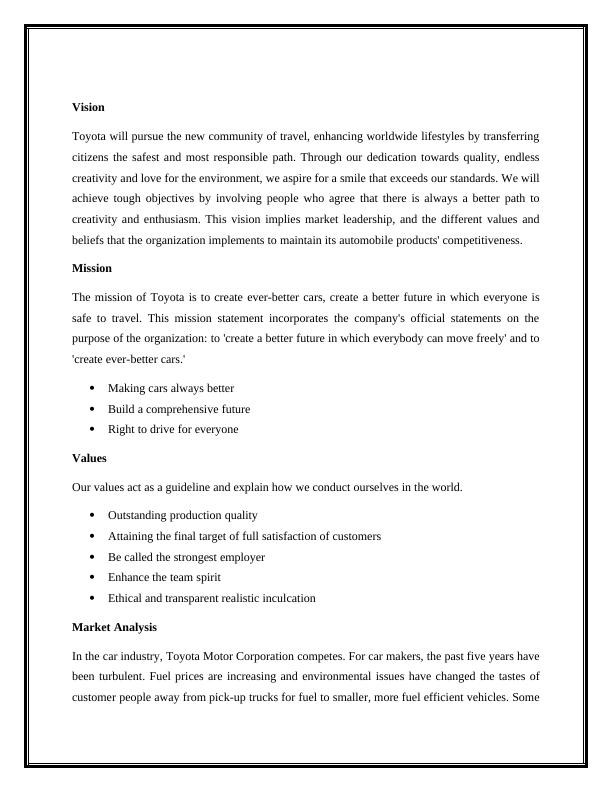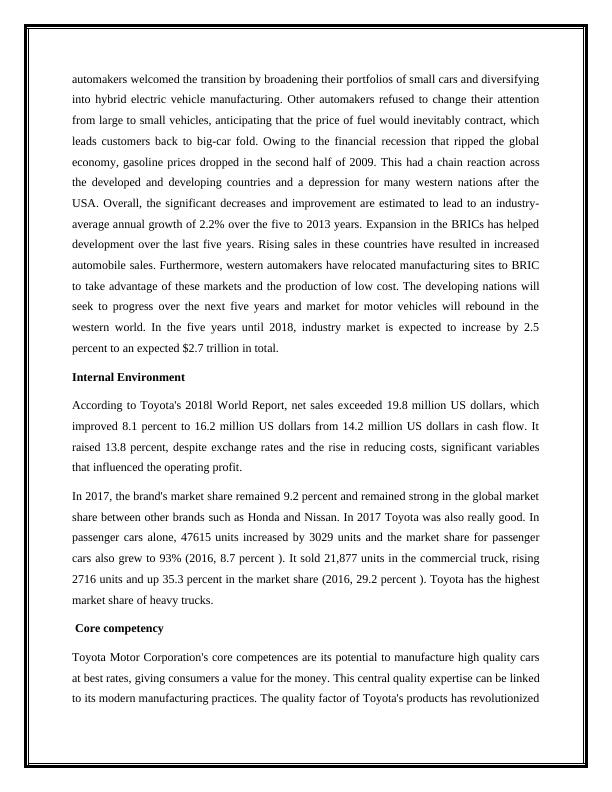Market Analysis of Toyota
15 Pages3862 Words25 Views
Added on 2021-01-05
Market Analysis of Toyota
Added on 2021-01-05
ShareRelated Documents
Table of Contents History...........................................................................................3 Vision.............................................................................................4 Mission............................................................................................4 Values.............................................................................................4 Market Analysis ...............................................................................5 STEEPLE Analysis............................................................................6 SWOT Analysis.................................................................................9 Product Life Cycle.............................................................................11 Market Segmentation..........................................................................12 Marketing Mix..................................................................................12 Future events....................................................................................16 References ........................................................................................16

Toyota Journey from Home to International MarketToyota was established in the Japanese spinning mills when Sakichi Toyoda developed the firstelectric loom in the world, which was then set up in 1918 by the Toyoda Spinning and WeavingFirm. His innovation minimized faults and improved returns since a platform ceased and after aproblem, it would not make defective material and use threads. Today's Toyota productionsystem remains vital to this concept of developing the machinery to dynamically intervene andinstantly turn attention to issues.The loom so impressed a British company, the Platt Brothers, that they purchased manufacturingand distribution rights for £100,000 in 1929. Sakichi offered his son, Kiichiro, the funds toimprove Toyoda automobile technology. The first passenger car the Company launched in 1936,the AA Model, and the company Toyota Motor was built in 1937. Toyota automobile startedproduction in 1959 in Brazil. Toyota produces brand automobiles and component partsworldwide, in addition to its own facilities, production subsidiaries and companies in Japan. Ithas headquarters in Toyota City, Aichi and Tokyo. Toyota offers also economic facilitiesthrough its Toyota Financial Services Division and also constructs robotics for various sectorsinstead of automobiles. The Toyota Motor Corporation and the Toyota Industries together formone of the largest corporations in the world and the backbone of the Toyota Company.Toyota is a world renowned company because of its high quality produced vehicles, and Toyotaservices, its manufacturing plants and its valuable loyal clients all over the world are rising verywell and very fast worldwide. Hybrid in Toyota cars' latest technology has given Toyota freshpride and regular sales of Toyota grow. Toyota was the number one automobile firm in the lastcouple of years and was the first to market mostly its cars internationally.

VisionToyota will pursue the new community of travel, enhancing worldwide lifestyles by transferringcitizens the safest and most responsible path. Through our dedication towards quality, endlesscreativity and love for the environment, we aspire for a smile that exceeds our standards. We willachieve tough objectives by involving people who agree that there is always a better path tocreativity and enthusiasm. This vision implies market leadership, and the different values andbeliefs that the organization implements to maintain its automobile products' competitiveness.MissionThe mission of Toyota is to create ever-better cars, create a better future in which everyone issafe to travel. This mission statement incorporates the company's official statements on thepurpose of the organization: to 'create a better future in which everybody can move freely' and to'create ever-better cars.'Making cars always betterBuild a comprehensive futureRight to drive for everyoneValuesOur values act as a guideline and explain how we conduct ourselves in the world.Outstanding production qualityAttaining the final target of full satisfaction of customersBe called the strongest employerEnhance the team spiritEthical and transparent realistic inculcationMarket AnalysisIn the car industry, Toyota Motor Corporation competes. For car makers, the past five years havebeen turbulent. Fuel prices are increasing and environmental issues have changed the tastes ofcustomer people away from pick-up trucks for fuel to smaller, more fuel efficient vehicles. Some

automakers welcomed the transition by broadening their portfolios of small cars and diversifyinginto hybrid electric vehicle manufacturing. Other automakers refused to change their attentionfrom large to small vehicles, anticipating that the price of fuel would inevitably contract, whichleads customers back to big-car fold. Owing to the financial recession that ripped the globaleconomy, gasoline prices dropped in the second half of 2009. This had a chain reaction acrossthe developed and developing countries and a depression for many western nations after theUSA. Overall, the significant decreases and improvement are estimated to lead to an industry-average annual growth of 2.2% over the five to 2013 years. Expansion in the BRICs has helpeddevelopment over the last five years. Rising sales in these countries have resulted in increasedautomobile sales. Furthermore, western automakers have relocated manufacturing sites to BRICto take advantage of these markets and the production of low cost. The developing nations willseek to progress over the next five years and market for motor vehicles will rebound in thewestern world. In the five years until 2018, industry market is expected to increase by 2.5percent to an expected $2.7 trillion in total.Internal Environment According to Toyota's 2018l World Report, net sales exceeded 19.8 million US dollars, whichimproved 8.1 percent to 16.2 million US dollars from 14.2 million US dollars in cash flow. Itraised 13.8 percent, despite exchange rates and the rise in reducing costs, significant variablesthat influenced the operating profit.In 2017, the brand's market share remained 9.2 percent and remained strong in the global marketshare between other brands such as Honda and Nissan. In 2017 Toyota was also really good. Inpassenger cars alone, 47615 units increased by 3029 units and the market share for passengercars also grew to 93% (2016, 8.7 percent ). It sold 21,877 units in the commercial truck, rising2716 units and up 35.3 percent in the market share (2016, 29.2 percent ). Toyota has the highestmarket share of heavy trucks. Core competencyToyota Motor Corporation's core competences are its potential to manufacture high quality carsat best rates, giving consumers a value for the money. This central quality expertise can be linkedto its modern manufacturing practices. The quality factor of Toyota's products has revolutionized

End of preview
Want to access all the pages? Upload your documents or become a member.
Related Documents
Toyota’s Operation Management (pdf)lg...
|10
|3004
|123
case of Toyota Assignment Samplelg...
|11
|2569
|295
Assignment Organizational Behaviorlg...
|18
|3787
|109
Principles of Logistic Management: A Case Study of Toyota Motorslg...
|14
|4388
|354
Customer Relationship Management (MGT 3604)lg...
|9
|2298
|101
Contemporary Issues in Logistics & Supply Chain Managementlg...
|15
|2880
|68
